
The Scarlet Pimpernel is the first novel in a series of historical fiction by Baroness Orczy, published in 1905. It was written after her stage play of the same title enjoyed a long run in London, having opened in Nottingham in 1903.

Baroness Emma Orczy, usually known as Baroness Orczy or to her family and friends as Emmuska Orczy, was a Hungarian-born British novelist and playwright. She is best known for her series of novels featuring the Scarlet Pimpernel, the alter ego of Sir Percy Blakeney, a wealthy English fop who turns into a quick-thinking escape artist in order to save French aristocrats from "Madame Guillotine" during the French Revolution, establishing the "hero with a secret identity" in popular culture.
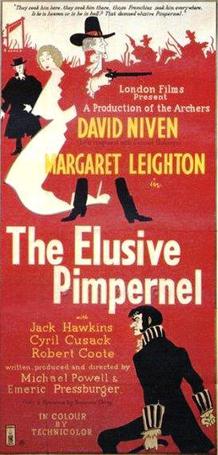
The Elusive Pimpernel is a 1950 British period adventure film by the British-based director-writer team of Michael Powell and Emeric Pressburger, based on the novel The Scarlet Pimpernel (1905) by Baroness Emmuska Orczy. It was released in the United States under the title The Fighting Pimpernel. The picture stars David Niven as Sir Percy Blakeney, Margaret Leighton as Marguerite Blakeney and features Jack Hawkins, Cyril Cusack and Robert Coote. Originally intended to be a musical, the film was re-worked as a light-hearted drama.
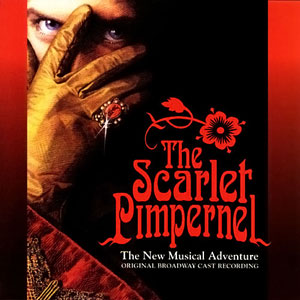
The Scarlet Pimpernel is a musical with music by Frank Wildhorn and lyrics & book by Nan Knighton, based on the 1905 novel of the same name by Baroness Orczy. The show is set in England and France during the Reign of Terror of the French Revolution. The story is a precursor to the spy fiction and the superhero genres, where a hero hides under a mild-mannered alias.
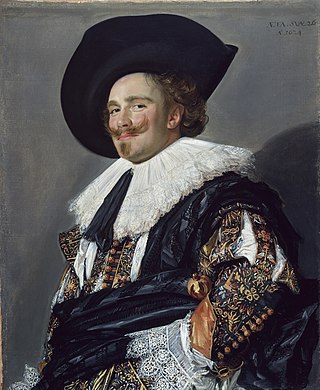
The Laughing Cavalier (1624) is a portrait by the Dutch Golden Age painter Frans Hals in the Wallace Collection in London. It was described by art historian Seymour Slive as "one of the most brilliant of all Baroque portraits". The title is an invention of the Victorian public and press, dating from its exhibition in the opening display at the Bethnal Green Museum in 1872–1875, just after its arrival in England, after which it was regularly reproduced as a print, and became one of the best known old master paintings in Britain. The unknown subject is in fact not laughing, but can be said to have an enigmatic smile, much amplified by his upturned moustache.

The Scarlet Pimpernel is a 1999 series of television drama programmes loosely based on Baroness Emmuska Orczy's series of novels, set during the French Revolution.
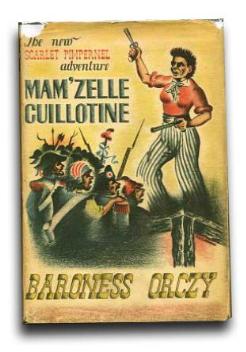
Mam'zelle Guillotine, by Baroness Orczy, is a sequel book to the classic adventure tale, The Scarlet Pimpernel. First published in 1940, it was the last novel Orczy wrote featuring the Pimpernel and is dedicated to those fighting in World War II.
"To all those who are fighting in the air, on the water and on land for our country and for our homes, I dedicate this because it is to them that we shall owe a happy issue out of all our troubles and a lasting peace." - Emmuska Orczy - Monte Carlo - 1939-40
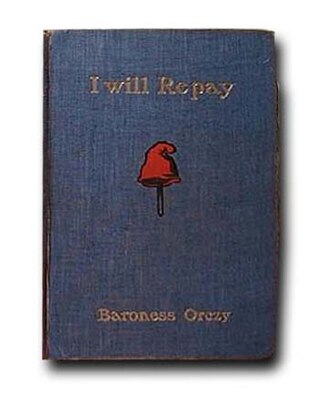
I Will Repay was written by Baroness Emmuska Orczy and originally published in 1906, this is a sequel novel to the Scarlet Pimpernel. The second Pimpernel book written by Orczy, it comes chronologically third in the series, after Sir Percy Leads the Band and before The Elusive Pimpernel.

First published in 1908, The Elusive Pimpernel by Baroness Orczy is the 4th book in the classic adventure series about the Scarlet Pimpernel.
Citizen Armand Chauvelin is the villain in Baroness Emmuska Orczy's classic novel The Scarlet Pimpernel and the various plays and films derived from the work.

The First Sir Percy: An Adventure of the Laughing Cavalier is a 1920 adventure novel by Baroness Orczy featuring Sir Percy Blakeney, ancestor of Orczy's character The Scarlet Pimpernel. It is a direct sequel to The Laughing Cavalier, occurring a few months after the events in the first book.

The Triumph of the Scarlet Pimpernel, first published in 1922, is a book in the series about the Scarlet Pimpernel's adventures by Baroness Orczy. Again Orczy interweaves historic fact with fiction, this time through the real life figures of Thérésa Cabarrus, and Jean-Lambert Tallien; inserting the Scarlet Pimpernel as an instigator of the role Tallien played in the Thermidorian Reaction in July 1794.
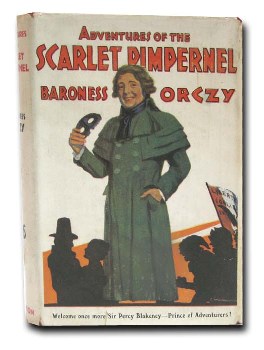
Adventures of the Scarlet Pimpernel is the second collection of short stories written by Baroness Orczy about the gallant English hero, the Scarlet Pimpernel and his League. Written in 1929 the stories, which are listed below, are set in 1793 but appear in no particular order. They occasionally refer to events in other books in the series and Orczy frequently reuses plot lines and ideas from the longer Pimpernel novels.

The Scarlet Pimpernel is a 1934 British adventure film directed by Harold Young and starring Leslie Howard, Merle Oberon, and Raymond Massey. Based on the 1905 play by Baroness Orczy and Montagu Barstow and the classic 1905 adventure novel by Orczy, the film is about an eighteenth-century English aristocrat (Howard) who leads a double life, passing himself off as an effete aristocrat while engaged in a secret effort to rescue French nobles from Robespierre's Reign of Terror. The film was produced by Alexander Korda. Howard's portrayal of the title character is often considered the definitive portrayal of the role. In 1941, he played a similar role in "'Pimpernel' Smith" but this time set in pre-WWII Germany.

The Scarlet Pimpernel is a 1982 British romantic adventure television film set during the French Revolution. It is based on the novels The Scarlet Pimpernel (1905) and Eldorado (1913) by Baroness Emmuska Orczy, and stars Anthony Andrews as Sir Percy Blakeney/the Scarlet Pimpernel, the protagonist, Jane Seymour as Marguerite St. Just, the love interest, and Ian McKellen as Chauvelin, the antagonist.

The Return of the Scarlet Pimpernel is a 1937 British film directed by Hanns Schwarz and starring Barry K. Barnes, Sophie Stewart, Margaretta Scott and James Mason. It is a sequel to the 1934 film The Scarlet Pimpernel based on the stories by Baroness Emmuska Orczy.

Nicolaes Hals, was a Dutch Golden Age painter.

I Will Repay is a 1923 British silent period film directed by Henry Kolker and starring Holmes Herbert, Flora le Breton, and Pedro de Cordoba. It was based on the 1906 novel I Will Repay by Emma Orczy, which is a sequel to The Scarlet Pimpernel. It was released in the United States under the alternative title Swords and the Woman.

Pieter Biesboer, is a Dutch art historian and prolific writer on 17th-century Dutch art. His specialty is art from Haarlem.

Yonker Ramp and His Sweetheart is an oil-on-canvas painting by the Dutch Golden Age painter Frans Hals, painted in 1623 and now in the Metropolitan Museum of Art, New York City. The painting has also been titled as Young Man and Woman in an Inn or Portrait of Pieter Ramp.






















